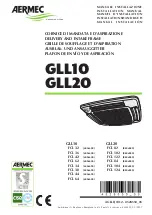
5 Installation
Installation and operation manual
11
RXYSQ6T7Y1B9
VRV IV-S system air conditioner
4P397285-1B – 2016.03
For more information on the state of the valves, refer to
"5.4.3 Checking refrigerant piping: Setup" on page 11
5.4.2
Checking refrigerant piping: General
guidelines
Connect the vacuum pump through a manifold to the service port of
all stop valves to increase efficiency (refer to
refrigerant piping: Setup" on page 11
).
NOTICE
Use a 2-stage vacuum pump with a non-return valve or a
solenoid valve that can evacuate to a gauge pressure of
–100.7 kPa (5 Torr absolute).
NOTICE
Make sure the pump oil does not flow oppositely into the
system while the pump is not working.
NOTICE
Do not purge the air with refrigerants. Use a vacuum pump
to evacuate the installation.
5.4.3
Checking refrigerant piping: Setup
p< p>
N2
C
b
c
e
a
g
f
d
A
B
a
Pressure reducing valve
b
Nitrogen
c
Weighing scales
d
Refrigerant R410A tank (siphon system)
e
Vacuum pump
f
Liquid line stop valve
g
Gas line stop valve
A
Valve A
B
Valve B
C
Valve C
Valve
State of valve
Valve A
Open
Valve B
Open
Valve C
Open
Liquid line stop valve
Close
Gas line stop valve
Close
NOTICE
The connections to the indoor units and all indoor units
should also be leak and vacuum tested. Keep any possible
(field supplied) field piping valves open as well.
Refer to the indoor unit installation manual for more details.
Leak test and vacuum drying should be done before the
power supply is set to the unit. If not, see also the flow
chart earlier described in this chapter (see
checking the refrigerant piping" on page 10
5.4.4
To perform a leak test
The leak test must satisfy the specifications of EN378‑2.
To check for leaks: Vacuum leak test
1
Evacuate the system from the liquid and gas piping to
–100.7 kPa (–1.007 bar/5 Torr) for more than 2 hours.
2
Once reached, turn off the vacuum pump and check that the
pressure does not rise for at least 1 minute.
3
Should the pressure rise, the system may either contain
moisture (see vacuum drying below) or have leaks.
To check for leaks: Pressure leak test
1
Break the vacuum by pressurising with nitrogen gas to a
minimum gauge pressure of 0.2 MPa (2 bar). Never set the
gauge pressure higher than the maximum operation pressure of
the unit, i.e. 4.0 MPa (40 bar).
2
Test for leaks by applying a bubble test solution to all piping
connections.
3
Discharge all nitrogen gas.
NOTICE
Make sure to use a recommended bubble test solution
from your wholesaler. Do not use soap water, which may
cause cracking of flare nuts (soap water may contain salt,
which absorbs moisture that will freeze when the piping
gets cold), and/or lead to corrosion of flared joints (soap
water may contain ammonia which causes a corrosive
effect between the brass flare nut and the copper flare).
5.4.5
To perform vacuum drying
To remove all moisture from the system, proceed as follows:
1
Evacuate the system for at least 2 hours to a target vacuum of
–100.7 kPa (–1.007 bar/5 Torr).
2
Check that, with the vacuum pump turned off, the target
vacuum is maintained for at least 1 hour.
3
Should you fail to reach the target vacuum within 2 hours or
maintain the vacuum for 1 hour, the system may contain too
much moisture. In that case, break the vacuum by pressurising
with nitrogen gas to a gauge pressure of 0.05 MPa (0.5 bar)
and repeat steps 1 to 3 until all moisture has been removed.
4
Depending on whether you want to immediately charge
refrigerant through the refrigerant charge port or first pre-charge
a portion of refrigerant through the liquid line, either open the
outdoor unit stop valves, or keep them closed. See
charge refrigerant" on page 12
for more information.
5.5
To insulate the refrigerant piping
After finishing the leak test and vacuum drying, the piping must be
insulated. Take into account the following points:
▪ Make sure to insulate the connection piping and refrigerant branch
kits entirely.
▪ Be sure to insulate the liquid and gas piping (for all units).
▪ Use heat resistant polyethylene foam which can withstand a
temperature of 70°C for liquid piping and polyethylene foam which
can withstand a temperature of 120°C for gas piping.
▪ Reinforce the insulation on the refrigerant piping according to the
installation environment.
Ambient
temperature
Humidity
Minimum thickness
≤30°C
75% to 80% RH
15 mm
>30°C
≥80% RH
20 mm
Condensation might form on the surface of the insulation.
▪ If there is a possibility that condensation on the stop valve might
drip down into the indoor unit through gaps in the insulation and
piping because the outdoor unit is located higher than the indoor
unit, this must be prevented by sealing up the connections. See
below figure.












































